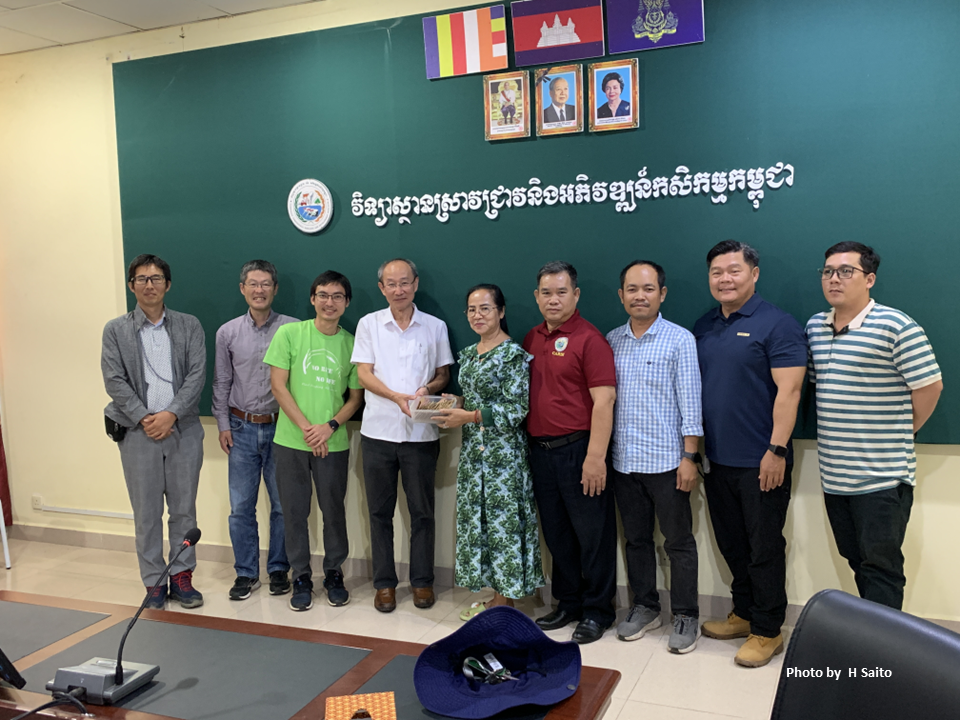Pick Up
1224: Rediscovered Legacy: The Return of Cambodia's Lost Genetic Resources

1224: Rediscovered Legacy: The Return of Cambodia's Lost Genetic Resources
On November 20, 2024, an academic research team led by Kobe University, in collaboration with the National Institute of Genetics (NIG) and the Japan International Research Center for Agricultural Sciences (JIRCAS), visited the Cambodian Agricultural Research and Development Institute (CARDI). During this visit, they returned seeds of 49 traditional Cambodian rice landraces that had been preserved at NIG to their homeland. These seeds were originally collected between 1957 and 1958 by Professor Hideo Hamada of Hyogo Agricultural College (now the Faculty of Agriculture at Kobe University) as part of the Southeast Asia Rice Cultivation Ethnographic Survey Team, in Vietnam, Cambodia, Laos, and Thailand.
For many years, the existence of these seeds had been forgotten, until they were accidentally rediscovered at Kobe University in 2006. Initially, it was believed that these seeds had lost their germination ability due to long-term storage at room temperature, rendering them worthless as genetic resources. However, it was later found that some of these seeds were preserved at NIG, leading to a reevaluation of their value as genetic resources. Subsequent investigations into their agricultural characteristics revealed that these landraces maintained higher genetic diversity compared to improved varieties, making them extremely valuable genetic resources for future rice breeding.
In Cambodia, diverse rice varieties have been selected and cultivated to adapt to the varied rice-growing environments centered around the Tonle Sap Lake. However, many of these varieties were lost due to severe restrictions on agricultural activities during the civil war in the 1970s and the subsequent replacement with modern improved varieties during the reconstruction period. The return of these traditional rice landraces is expected to restore lost genetic resources, recover genetic diversity in Cambodia, and contribute to future rice breeding.
It is estimated that there are about 8.7 million species of organisms on Earth, of which approximately 7,000 plant species have been utilized in human social activities. However, currently, 30 crop species provide 95% of the food energy for humanity, with just four species (rice, wheat, maize, and potatoes) accounting for over 60%. This reliance on a small number of crops leads to a loss of genetic diversity, increasing vulnerability to future climate change and pest outbreaks. Therefore, it is crucial to collect and preserve diverse genetic resources, evaluate their characteristics, and establish a system for their advanced utilization. This will help develop crops that can adapt to various anticipated environmental changes, thereby contributing to food security.
The cultivated varieties of crops that form the foundation of today's agriculture are believed to have been formed over 10,000 years ago through the selection of relatively simple traits such as non-shattering seeds, non-dormant seeds, and the size of edible parts like seeds and fruits. Over the long history of cultivation, these varieties have been selected for traits suited to the local climate of each cultivation area, maintaining a wide variety of landraces with high utility for humanity. Therefore, landraces are time capsules that preserve the genetic diversity of the past while possessing excellent diverse traits.
However, the opportunities to cultivate landraces have decreased due to the spread of semi-dwarf varieties that contributed to the Green Revolution, which dramatically increased food production, and the advancement of modern intensive agriculture. Additionally, the rapid climate change in recent years, deforestation, industrialization, urbanization, and international conflicts and civil wars have led to the destruction of natural ecosystems, raising concerns about the extinction and depletion of many species.
The collection and preservation of genetic resources and their evaluation are steady activities, but they play a crucial role in ensuring future food security and responding to environmental changes. In JIRCAS, through the grant-in-aid project research (C4 Tropical Crop Resources), efforts are being made to preserve genetic resources, evaluate their diversity, and explore and develop useful genetic resources for breeding materials. In this academic joint research, field characteristic surveys of these landraces, which are difficult to cultivate on the main island of Japan, were conducted at the Tropical Agriculture Research Front of JIRCAS (Ishigaki City, Okinawa), contributing to the elucidation of genetic diversity. Through ongoing research activities that maximize the use of genetic resources, we aim to achieve sustainable agriculture.
Contributor: SAITO Hiroki, Tropical Agriculture Research Front (TARF)
